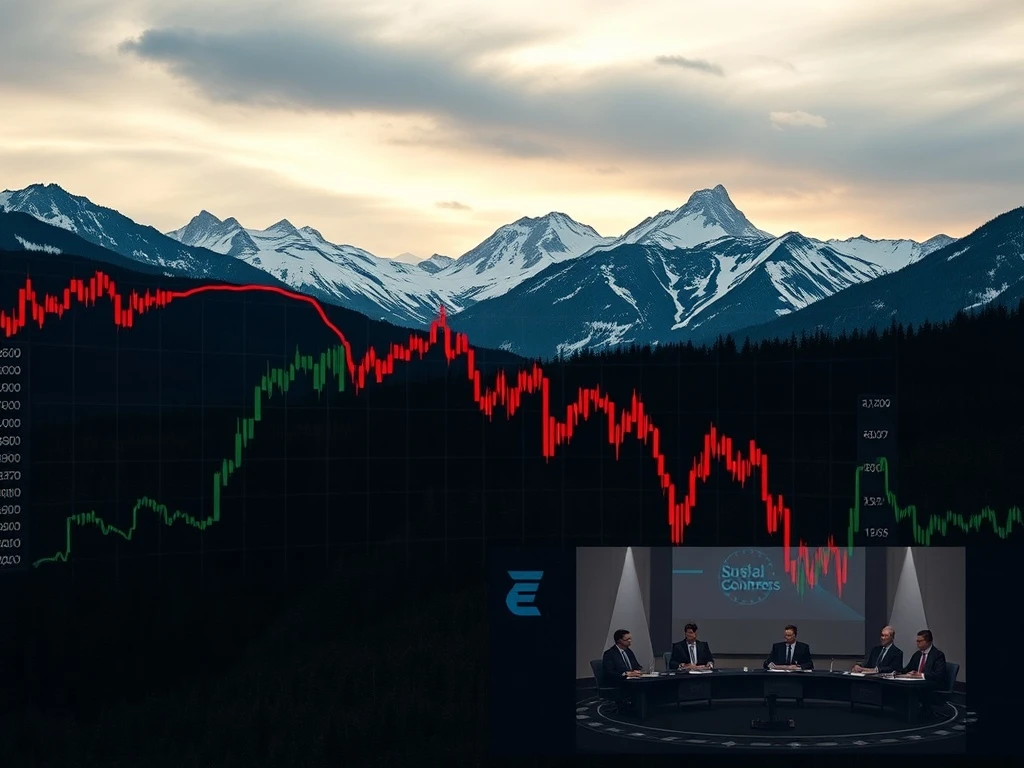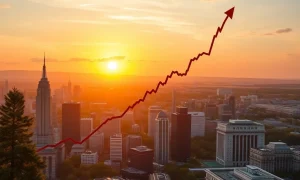The annual Jackson Hole Economic Symposium often serves as a pivotal moment for global financial markets. Indeed, investors worldwide eagerly await pronouncements from central bankers gathered in Wyoming. This year, the stakes appear particularly high. A leading strategist warns that without a specific, reassuring signal from this event, the stock market could face a sharp 15% decline. Understanding this potential trigger is vital for market participants.
Understanding the Jackson Hole Symposium’s Influence
The Jackson Hole Economic Symposium is an annual gathering of central bankers, finance ministers, academics, and financial market participants from around the world. The Federal Reserve Bank of Kansas City sponsors this event. Furthermore, it provides a crucial forum for discussing long-term policy issues. Historically, significant policy shifts or forward guidance have often emerged from these meetings. Therefore, market participants pay close attention to any subtle or overt cues regarding future monetary policy.
This symposium is not merely a talk shop. Rather, it has a history of setting the tone for upcoming central bank actions. For instance, in previous years, chairs of the Federal Reserve have used this platform to signal major policy changes. Consequently, any perceived lack of clarity or a surprisingly hawkish stance can significantly impact market sentiment. The market’s reaction to the Jackson Hole signal can be swift and severe.
The Critical Signal for Stocks
Strategists are specifically looking for a clear indication of the Federal Reserve’s future monetary policy path. More precisely, they seek reassurance that the Fed will not adopt an overly aggressive stance. This crucial signal involves the Fed’s outlook on interest rates and its approach to quantitative tightening. A dovish tone, or at least a less hawkish one than anticipated, is what the market desires. Conversely, a failure to provide this reassurance could lead to significant market turbulence.
Market participants generally expect the Fed to acknowledge progress on inflation while also indicating flexibility. For example, if the Fed Chair signals a continued commitment to high interest rates without clear data dependency, it could spook investors. This is because higher rates can suppress economic growth and corporate earnings. Therefore, the **Jackson Hole** signal needs to strike a delicate balance.
Why a 15% Stock Market Slide is Feared
A 15% stock market slide represents a substantial correction. Such a decline typically occurs when investors lose confidence in the economic outlook or central bank policy. The current market environment is particularly sensitive to monetary policy. This sensitivity stems from lingering inflation concerns and the ongoing debate about a potential recession. Moreover, corporate earnings forecasts remain under scrutiny.
Several factors contribute to this fear:
- Interest Rate Expectations: If the Fed signals higher-for-longer interest rates, it increases borrowing costs for businesses and consumers. This can slow economic activity.
- Quantitative Tightening: Continued reduction of the Fed’s balance sheet drains liquidity from the financial system. Less liquidity often means less capital available for investment.
- Economic Outlook: Any perceived pessimism from the Fed regarding economic growth or employment could trigger sell-offs. Investors seek signs of stability and growth.
- Valuation Concerns: Many stocks, particularly in the tech sector, have high valuations. These are especially vulnerable to rising interest rates and economic uncertainty.
Therefore, without the right **Jackson Hole** signal, the market could quickly reprice assets downwards.
Historical Precedent and Market Reactions
History offers several examples of how Jackson Hole speeches have moved markets. In some instances, Fed chairs have used the platform to announce significant policy shifts. Other times, their remarks have merely reinforced existing expectations. However, even subtle shifts in language can be scrutinized intensely by analysts and traders. The market often overreacts to perceived changes in central bank rhetoric.
Consider past symposiums where the Fed signaled tapering of asset purchases. These announcements often led to periods of market volatility. Similarly, hints about future rate hikes have caused bond yields to spike and equity markets to pull back. Therefore, the market’s current anticipation of the **Jackson Hole** meeting is well-founded. Investors recall previous market reactions and prepare accordingly.
Key Players and Their Potential Influence at Jackson Hole
While many influential figures attend, the speech by the Federal Reserve Chair typically garners the most attention. Their words carry immense weight. Other key central bankers from the European Central Bank or Bank of Japan also speak. Their insights provide a global economic perspective. However, the Fed Chair’s outlook on U.S. monetary policy remains paramount for domestic markets.
Analysts will dissect every word, looking for nuances in tone and specific phrases. They will compare the current rhetoric to previous statements. Any deviation could be interpreted as a shift in policy direction. Furthermore, the Q&A sessions, if any, also offer valuable insights. The collective wisdom shared at **Jackson Hole** helps shape the market narrative for months to come.
Navigating the Market Ahead of Jackson Hole
Investors face a period of heightened uncertainty leading up to and immediately following the Jackson Hole symposium. Prudent strategies often involve reviewing portfolio allocations. Some investors might reduce exposure to highly volatile assets. Others might consider increasing their cash positions. Diversification remains a key principle during such times.
Analysts advise caution rather than making drastic moves based on speculation. Instead, focus on understanding the underlying economic data. Pay attention to inflation trends, employment figures, and corporate earnings reports. These fundamentals will ultimately drive long-term market performance. The **Jackson Hole** meeting provides an important, yet single, data point.
Potential Outcomes and Investor Strategies
There are generally two broad outcomes strategists consider for the Jackson Hole symposium. The first involves the Fed delivering the reassuring signal. This would likely involve acknowledging progress on inflation and signaling a data-dependent approach to future rate decisions. Such an outcome could lead to a relief rally in stocks, potentially preventing the feared 15% slide. Investors might then see opportunities in growth stocks and technology.
Conversely, the second outcome involves the Fed adopting a surprisingly hawkish stance. This could mean a strong commitment to higher rates for longer, or a dismissal of recession fears. This scenario would likely trigger the significant market downturn. In this case, defensive stocks, commodities, and fixed income might offer more stability. Ultimately, preparedness is key for investors regardless of the **Jackson Hole** outcome.
The upcoming Jackson Hole Economic Symposium is undoubtedly a critical event for the stock market. A clear, reassuring signal from the Federal Reserve could avert a significant downturn. However, a lack of such guidance, or an unexpectedly hawkish tone, could indeed lead to a sharp 15% stock market slide. Investors should monitor the proceedings closely and adjust their strategies accordingly. The market’s stability hinges on the messages conveyed at this influential gathering.
Frequently Asked Questions (FAQs)
What is the Jackson Hole Economic Symposium?
The Jackson Hole Economic Symposium is an annual conference hosted by the Federal Reserve Bank of Kansas City. It brings together central bankers, finance ministers, academics, and financial market participants from around the world to discuss long-term policy issues affecting the global economy.
Why is the Jackson Hole Symposium important for the stock market?
The symposium is crucial because Federal Reserve officials, particularly the Fed Chair, often use it to provide insights into future monetary policy. These insights can significantly influence market expectations regarding interest rates, inflation, and economic growth, directly impacting stock valuations.
What kind of signal are strategists looking for at Jackson Hole?
Strategists are primarily looking for a clear and reassuring signal from the Federal Reserve regarding its monetary policy path. This typically means an indication that the Fed will not be overly aggressive with interest rate hikes or quantitative tightening, suggesting a data-dependent and flexible approach.
What could cause a 15% stock market slide after Jackson Hole?
A 15% stock market slide could occur if the Federal Reserve adopts a surprisingly hawkish stance at Jackson Hole. This might involve a strong commitment to higher interest rates for a longer period, or a dismissal of economic slowdown concerns, leading investors to reprice assets downwards due to increased borrowing costs and reduced liquidity.
How should investors prepare for the Jackson Hole event?
Investors should prepare by reviewing their portfolios and considering diversification. Some might reduce exposure to highly volatile assets or increase cash positions. It is also wise to focus on underlying economic data and avoid drastic moves based solely on speculation, instead awaiting clear policy signals.
















